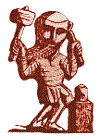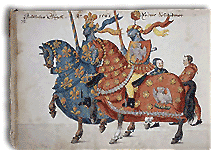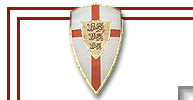|
|
MEDIEVAL COINS
The Crusader Kingdoms
and the Christian East
*Click on images to see larger images.*

Crusaders gold Dinar, imitating a
Fatamid gold Dinar of al-Amir.
Second Phase, ca. AD 1148 to 1187.
Denomination: Gold Dinar (or Bezant).
Mint: The exact location of minting of this series
is uncertain, but most likely it was the city of Acre.
Date: This coin is from the 2rd phase in this
series, thought to have been struck between about AD 1148 and
1187.
Reference: Coinage in the Crusader States -page 116,
#3 is
the closest match. The prototype coin being imitated is a fatamid
dinar of Al-Amir of Misr (Cairo), Album type 730.
Size: 21.0 x 21.8 mm. Weight: 3.48
grams.
Grade: aXF, with a fairly good strike.
Obverse and Reverse: Pseudo Arabic inscriptions,
but are in part well enough engraved to be legible.
SOLD
Order
# 4483
|

Crusaders at Antioch. Bohemund III,
minority of AD 1149 to 1163. Silver Denier.
Denomination: Silver denier.
Mint: Antioch.
Reference: Metcalf Crusader 348 class B.
COINS OF THE CRUSADER STATES - page 205 to 206, #26 (square A and V,
anulet).
Size: 15.0 x 16.1 mm. Weight: 0.79
grams.
Grade: aXF
Obverse: Bare head of Bohemond III, with long hair,
with BOHEMONDVS around.
Reverse: Short cross with an anulet in the upper
left, all within a circle, with ANTIOCHIA
around.
SOLD
Order
# 4571
|

Crusader. Rhodes. Juan
Fernandez of Heredia, AD 1376 to 1396, Silver Gigliato.
Juan Fernadez of Herdia was the Grand Master of
the Order of the
Knighs Hospitallers of St. John of Jersualem, at Rhodes from AD 376 to
1396. While technically later than what is thought of as the
Crusader
period, most collectors include these coins in the crusader series
(just as they do othe coins of the Kingdom of Cyprus right into the
16th century).
Denomination: Silver denier.
Mint: Rhodes.
Size: 28.4 x 28.7 mm. Weight:
3.93 grams.
Reference: Met. 1214 to 16 variety., CCS
25g (page 526).
Grade: VF with typical weakness and
difficult to read inscriptions. Attractively tone.
Obverse: Grand master kneeling beore a
patriarchal cross on steps, with a castle behind and an "G" below the castle. In it's ideal form
the inscription around would read, starting at the initial cross at 12
o'clock, FR IOANES FERDINANDI DEI GRA M,
but the inscription on this coin is a variation on that, with some
different abreviations, some letters llgate, and because of some weak
areas I cannot quit work it out exactly.
Reverse: Cross fleury, and in it's ideal
form the inscription around would read OSPITALIS
IOHIS IRL'NI 9T RODI,
but it a number of the letters appear to be ligate or completely on top
of one another, making the exact wording hard to work out.
SOLD
Order
# 3308
|

Crusaders
in Tripoli. Bohemond VII,
AD 1275-1287. Silver half Gros.
Denomination: Silver half gros.
Mint: Tripoli.
Date: AD 1275 to 1287.
Reference: Coinage in the Crusader States -Tripoli
#27.
Size: 18.7 x 19.5 mm. Weight: 2.12
grams.
Grade: VF with some weak areas.
Obverse: Cross in a circle of twelve arches, with SEPTIMVS BOEMVNDVS COMES around.
Reverse: Triple towered two story gateway, in a
circle of twelve arches, with CIVITAS
TRIPOLIS SVRIE around.
SOLD
Order
# 3323
|
|
We have made every effort to describe
each coin as clearly as possible, with inscriptions provided as we have
read them from the coins. Unfortunately, the medieval letter forms, and
often less-than-perfect strikes, can make the coins difficult to read
and we may occasionally get a letter or two wrong. Please feel free to
contact us if you notice any such mistakes.
|
ALL PRICES ARE IN US DOLLARS
CANADIAN ORDERS MUST ADD GST/HST TO ALL PRICES
FOR ADDITIONAL MEDIEVAL COINS WE HAVE AVAILABLE
PLEASE SEE OUR VCOINS STORE
www.vcoins.com/calgarycoin
Next page of Medieval Coins
Top of Page
 
THE CHRISTIAN EAST
CILICIAN ARMENIAN KINGDOM
Armenia was a medieval Christian Kingdom located near
the borders of Turkey, Syria and Iran, a region normally associated
with Islam. The coins have distinctly Christian images, often the king
on horseback, holding a cross. The legends are of a distinctive
Armenian script that is still in use today, but some examples have
bilingual Armenian-Arabic inscriptions, attesting to the close ties
these people had with the local Islamic cultures.
LEVON I, AD 1199-1216
HETOUM I, AD 1226-1269
|
Top of Page

Copyright © 1997-2013 R & T Enterprises Ltd.
|
 |
|








